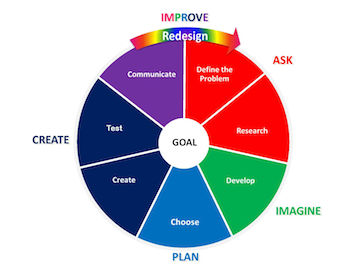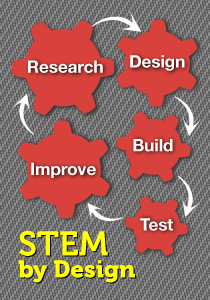STEM & Math Teachers
Thanks for all the comments in my first post! I’ve been chewing on the question Marsha Ratzel raised there:
”What if you’re the math teacher who is having to work in isolation from the science teachers? Are STEM lessons still a possibility? Or are these lessons and this idea only possible in a school where the different content areas are willing to collaborate?”
Great question, Marsha. STEM lessons are always a possibility in any situation. In fact, I’m taking a wild guess that not many of you readers work in a school where math and science teachers meet together to integrate their teaching and develop STEM curriculum.
Based on some work I’ve done with 6th and 7th grade teachers (and will be doing with 8th grade teachers), I’ll share some of my takeaways.
First, you can always search out STEM curriculum that’s already been developed. A lot of good lessons appear online at sites such as eGFI, Try Engineering, and Teach Engineering. But be watchful! Not everything that is called a STEM lesson actually involves engineering. Some are just good science experiments.
So how do you know if it’s a STEM lesson? STEM is a type of project-based learning that focuses on real-world problems. Students explore and apply science and math knowledge using the engineering design process (more on that below). Students use what they learn in math and science to create a technology or a solution for a problem. Technology, by the way, is anything created to meet a human want or need. A chair is technology. A pencil is technology. A Pez dispenser is technology!
One example, to clarify:
Suppose: You ask student teams to build clay barriers in a piece of guttering and conduct a controlled experiment to determine the effect of shape, size, and number of barriers on the flow rate of water. They’ve just conducted a good science/math experiment. Then: If teams use that information to design and construct a system of barriers in a model streambed (the gutter) to try to slow down the rate at which water dumps sediment into the watershed (a bucket), that’s an engineering challenge. See the difference? STEM lessons focus on using science, math, and technology to solve a problem. If you want to do a STEM lesson, be sure you have the E in STEM – the engineering approach.
Second, you can write and implement STEM lessons, even without collaboration with other teachers. A few hopefully helpful hints:
• Stay on track with your course of study and pacing guides by checking out the math and science objectives for the quarter you plan to use the STEM lesson/unit. Try to incorporate some of these objectives. In the lesson example above, math objectives included rate and unit rate, and science objectives included environmental pollution. A savvy teacher, looking to help kids make connections, could build a strong math STEM activity around a science topic students are studying.
• Plan for students to work in teams, and give them good strategies for doing that successfully. I’ll be happy to post some things students should be able to do to become good team players if anyone wants that information.
• Get your students engaged with hands-on activities. Imagine those student teams in their math classroom, pouring water down guttering to measure flow rate with and without barriers. Brave math teachers, indeed! And highly engaged students as well.

- Identify the problem or need
- Do background research
- Generate alternative solutions
- Choose the best solution
- Create a model or prototype
- Test and evaluate
- Redesign
You’ve just read my thinking about STEM lessons. Feel free to disagree! Why not add your thoughts, or a description of a STEM lesson you’ve done? And, while you’re at it, some of your favorite STEM lesson websites as well.
































Dear Anne,
Thanks for this great thinking piece. It really helped me differentiate between what I’m trying to do in math and how these kinds of tasks would become a STEM kind of learning experinece.
So here’s my current dilemma…. I have a number of students that have pre-tested out of a unit on slope. I want to have them simulate a leaking faucet, collect the data about the volume of water lost per 5-second intervals. The math part of this asks them to predict how much will be lost in a week, a month, a year and so on. I can also amp up the math by adding in how much it will cost…giving them practice using decimals and algebra.
If I’m understanding you correctly, in order for this to be more of a STEM thing, I’d need to then hook the leaking faucet to a real world problem. That’s sort of where I get stuck. I’d expect 8th graders to say replace the washer or the entire faucet. So what kind of real-world problem could I rewrite this problem into to give them an engineering design problem associated with dripping water???? Thanks Anne I’m looking forward to hearing your ideas and I hope that my dilemma is where other people might be stuck, too…so your answer could help them, too.
Hi, Marsha —
Anne is a terrific colleague of mine and we work together in developing those STEM design challenges she mentioned in an earlier post. First let me say, as a former middle grades math teacher, I am so impressed to see you out there doing everything you can to give your students real integrated STEM experiences and connecting the math they are learning to some meaningful applications. Kudos to you!!
I’m familiar with the dripping faucet problem — and, I agree, these savvy 8th graders might just say, “Go buy a washer” — (but, having watched my husband do just that — it is no simple process and requires problem solving; unfortunately that solution doesn’t involve slope!) I’m wondering if you couldn’t connect the lesson to the real 21st century problem of sufficient supply of clean water (which is one of the identified engineering grand challenges for this century). You could ask the students to do some research to determine how much of a problem the leaky faucet poses as part of a community awareness campaign. Part of the research could include determining the scope of the problem using the lesson you described. But ideally, it would go further — and involve more integration of subjects and get more “real”. This is where having other teachers partner with you is so valuable. A related science or language arts research investigation could be – what exactly happens to that wasted water? Is it recycled back into the community’s water works system. Is there a substantial additional cost involved to the community? What is the cost to the owner of the leaky faucet? Could we gather data to see how many families have leaky faucets? Perhaps there are some graphs the students could look at that show an approximately linear relationship between some of these variables over time. The students could then explore the slope of the trend line and determine the average rate of change and then project the problem’s impact in the future.
But, wow…..I can hear you thinking — given my situation — developing something like this is going to take way more time than I have!! And, you are probably right. I just wanted to put it out there to show how valuable it is if you can get teachers from other content areas to join you on your STEM mission. Our writers have found that developing meaningful integrated STEM lessons is a rather challenging task, especially when you don’t have folks with different perspectives to help develop the ideas and lessons. In the beginning we had 3 math teachers doing the writing – and I was one of them. Now we have science (Anne was our first science writer added to the team — and what a great addition!), engineering and math educators, industry practitioners, and most importantly – experienced teachers on the writing team. The STEM modules are so much richer and more authentic today – and the middle grades students are even more engaged. We are all learning so much about our specific content fields and how they connect to and are applied in the world of work. We are learning how we sometimes use different words in math and in science that mean the same thing – and the students fail to see the connections.
Well I’m rambling on now –I do tend to get carried away with the topic of STEM! Marsha, I hope you’ll continue trying to find those rich opportunities to connect math to how it is used to solve problems in our world. Anytime you do that, students will be gaining a greater appreciation for the value of math in their world. And… I hope you’ll keep up the dialogue on this blog and continue to engage your science colleagues in your quest – maybe initially through just asking for their suggestions of connections, perhaps a monthly STEM supper discussion group??
Best wishes this coming year — I’ll watch for your posts….Susan
Dear Susan,
Thank you for your words of encouragement and ideas.
I’m also glad you clarified for me the issue. I had thought of doing some of the extensions you mentioned, but I didn’t realize they would be STEM. Goes to show that I didn’t realize that defining the parameters of the problem along with its costs to the community would be “engineery” enough because it didn’t offer solutions.
Thanks for your help and I definitely know what I’m going to do now.
I hope you’ll clue us in on your STEM project as you do it, Marsha! Watching projects unfold is a great way of learning!
As far as slope goes, math students can have a lot of fun and engagement when determining the relationship between slope and flow rate. Imagine using a piece of guttering (or PVC pipe sliced vertically) and letting the kids determine how the angle of the guttering affects the velocity of the water flowing down it. No need to reinvent the wheel on that. If it sounds like something you’d like to do I’ll send you a math lesson on that. The STEM challenge might involve coming up with a process for controlling the flow rate.
Marsha blogs about her teaching practice at Reflections of a Techie. She wrote about this exchange in a recent post there.
Have you seen the teacher-made video that won Ed Week’s #MTT2K for the most entertaining and enlightening video engaging Khan Academy’s approach to “blended learning”? It’s a thoughtful and powerful argument in favor of engaging students in the struggle to figure out how to do things. The focus is on math learning. The teacher titled it What If Khan Academy Was Made in Japan.